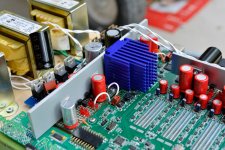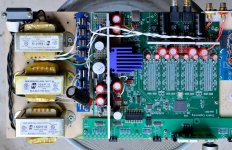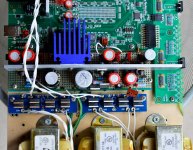Is there any interference from this connection?
This connection, unlike the cmos port on the 1021 does not pass through galvanic isolation, so if you think a direct connection between your PC ground bus and the dac is ok go ahead and do it 😛
I think the Wima caps were 1.2n, but could be wrong. Anyway, the value is not critical, make sure you also listen with no caps.
Thanks to you both for your advice.
I guess I will have to do without easy polarity switching!
I listened to the first DAC without a lowpass filter but eventually went back.
My fanciful conception of both the removal of this cap along with the ceramic bypasses is due to using a computer for music storage, somehow, masks the sound of these devices being removed, taking SOEKRIS's word that he installs these for good reason. Is it a consequence that all who have noticed this improvement are using a computer for music storage? A strange form of serendipity? Whereas using an SD card player might well sound better with both in place since the player will not have anywhere near the level of noise in the background. Kind of like fighting fire with fire - more noise on the SOEKRIS board due to the removal of the supply bypass caps masks the noise of the computer? The quieter source benefits from the bypass caps remaining in place? Pure conjecture, of course.
Problem with removing the ceramics is that I could never get them back into place.
I have some of those silver micas that SPEC CORP has made for them that should work really well.
One wonders what one of abraxalito's filters would sound like? Where he compensates for the "NOS droop". Been so long since i used a SOEKRIS DAC that I cannot remember if it droops in NOS mode like all of the rest.
Thanks, again,
I guess I will have to do without easy polarity switching!
I listened to the first DAC without a lowpass filter but eventually went back.
My fanciful conception of both the removal of this cap along with the ceramic bypasses is due to using a computer for music storage, somehow, masks the sound of these devices being removed, taking SOEKRIS's word that he installs these for good reason. Is it a consequence that all who have noticed this improvement are using a computer for music storage? A strange form of serendipity? Whereas using an SD card player might well sound better with both in place since the player will not have anywhere near the level of noise in the background. Kind of like fighting fire with fire - more noise on the SOEKRIS board due to the removal of the supply bypass caps masks the noise of the computer? The quieter source benefits from the bypass caps remaining in place? Pure conjecture, of course.
Problem with removing the ceramics is that I could never get them back into place.
I have some of those silver micas that SPEC CORP has made for them that should work really well.
One wonders what one of abraxalito's filters would sound like? Where he compensates for the "NOS droop". Been so long since i used a SOEKRIS DAC that I cannot remember if it droops in NOS mode like all of the rest.
Thanks, again,
I guess I will have to do without easy polarity switching!
I listened to the first DAC without a lowpass filter but eventually went back.
Тhere is another option: a small Arduino board with a switch. Whenever you want to change polarity power up the board and send a command, after that power the board down. I seem to notice when the Arduino is up, but if you don't it's even better - you can use a remote control.
I doubt the PC/USB is the reason why i prefer no caps, more likely it is the valve preamp which filters above 100kHz more efficiently than the onboard filter.
use an optical connection (toslink) to your DAC.
Toslink connection is the most jittered input of this DAC.
From this point of view, the most optimal choice is I2S, then USB .... if you use dedicated power supply for USB chip.
The board's USB input power and ground is the most significant source of noise. Till I don't change my USB +5V to the low noise power supply, I continuously hear the source (SOtM 200) power supply noise.
Say after me - slooowly: b u f f e r + r e c k l o c k i n g...
When the payload is being used by the DAC proessing, none (0, silch, niente, nada, zero, inget) of the timing aspects of the toslink layer one (L1) remains.
//
When the payload is being used by the DAC proessing, none (0, silch, niente, nada, zero, inget) of the timing aspects of the toslink layer one (L1) remains.
//
Last edited:
This is a very convincing sounding theory, which sadly is not supported by my listening experience. Same applies to Ian's fifo.
Otoh, you may be right about optical sounding best, i wouldn't know. At least, it does not pass through the galvanic isolators.
Otoh, you may be right about optical sounding best, i wouldn't know. At least, it does not pass through the galvanic isolators.
When I'm technically convinced of a superior solution for a part of my system I keep using it and change other things to reach my goals. As I recall it, using toslink withe the DAM dac for the first time wasn't a ball out of the park but I'm glad a stuck with it and now I would not use anything else. Max 192k is fine with me.
//
//
Hi Søren,
Is J3 a jumper for usb mode switching like dac1951?
Thanks!
I figured that USB Audio Mode 1 was not needed anymore, now that Windows finally supports USB Audio Mode 2. But I left the possiblity to still switch to USB Audio Mode 1 using a jumper, that would be J3....
Thanks to you both for your advice.
I guess I will have to do without easy polarity switching!
I listened to the first DAC without a lowpass filter but eventually went back.
My fanciful conception of both the removal of this cap along with the ceramic bypasses is due to using a computer for music storage, somehow, masks the sound of these devices being removed, taking SOEKRIS's word that he installs these for good reason. Is it a consequence that all who have noticed this improvement are using a computer for music storage? A strange form of serendipity? Whereas using an SD card player might well sound better with both in place since the player will not have anywhere near the level of noise in the background. Kind of like fighting fire with fire - more noise on the SOEKRIS board due to the removal of the supply bypass caps masks the noise of the computer? The quieter source benefits from the bypass caps remaining in place? Pure conjecture, of course.
Problem with removing the ceramics is that I could never get them back into place.
I have some of those silver micas that SPEC CORP has made for them that should work really well.
One wonders what one of abraxalito's filters would sound like? Where he compensates for the "NOS droop". Been so long since i used a SOEKRIS DAC that I cannot remember if it droops in NOS mode like all of the rest.
Thanks, again,
I am strongly under the impression if you can hear a difference between the LP NP0 ceramic being removed then its all in your upstream. In my case I have not heard any difference with the cap as without it, however that was noticed only after adding polystyrene caps after not using any LP caps for a good year or so. I simply kept them there. I don't believe anyone has actually stated any hard negatives of the stock NP0 caps.
Last edited:
I don't believe anyone has actually stated any hard negatives of the stock NP0 caps.
I am positive i have 🙂
I am positive i have 🙂
Yes I remember now, there may have been improvements just by removing them initially, I just had no difference when adding some nice proper polystyrene caps. The removal of my NP0 caps coincided with major upgrades to the 3.3V rail in my build among other things.
Currently I use my 1941 to drive a differential tube stage, so two 801A triodes which play into a LL1692AM with a CCS on their cathodes, Rod Coleman Heater regs.
I would like to investigate now how the sound difference is between the PP-Setup compared to a SE-Setup. It is great that Soekris offers the switch in the firmware to switch from differential ouput with 620 ohm to SE with 310 ohm.
May I ask: Do I have to physically connect the originally plus and minus signal output to sum the signal of both resistor network up or is this done DAC-Internally ? I would guess that the current plus and minus tap need to be connected with a small cable, correct ?
I would like to investigate now how the sound difference is between the PP-Setup compared to a SE-Setup. It is great that Soekris offers the switch in the firmware to switch from differential ouput with 620 ohm to SE with 310 ohm.
May I ask: Do I have to physically connect the originally plus and minus signal output to sum the signal of both resistor network up or is this done DAC-Internally ? I would guess that the current plus and minus tap need to be connected with a small cable, correct ?
You need to physicaly connect plus and minus outputs.
The firmaware changes only the negative phase.
The firmaware changes only the negative phase.
My fanciful conception of both the removal of this cap along with the ceramic bypasses is due to using a computer for music storage, somehow, masks the sound of these devices being removed, taking SOEKRIS's word that he installs these for good reason.
Certainly there is one good reason:
It should be said that I have a strong preference for SMT parts as otherwise I couldn't make them in Denmark at a reasonable price....
I guess my work on a DAC is done, there's not much I can change anymore.
Overall, I have five Salas regulators: 2 in Vref section and 3 in digital section. Each regulator is powered from a separate winding on a transformer.
The USB circuit and display have their own regulators. In a picture, you can see one of the filter caps hanging in a socket; this is from display regulator, as I wanted to see if there is any influence on a sound from this section. Surprisingly, it affects the sound very much and premium parts were needed here as well.
Overall, I have five Salas regulators: 2 in Vref section and 3 in digital section. Each regulator is powered from a separate winding on a transformer.
The USB circuit and display have their own regulators. In a picture, you can see one of the filter caps hanging in a socket; this is from display regulator, as I wanted to see if there is any influence on a sound from this section. Surprisingly, it affects the sound very much and premium parts were needed here as well.
Attachments
Last edited:
Peter...five ???
Wow.
Can you elaborate why you took this decision and what it did to sound ? I am still on two for analog / Vref and rest is the stock reg at the moment...I thought to change the stock digital out for a Salas...but not sure if that is worth it, but you actuall topped this with actually three more ??.
Wow.
Can you elaborate why you took this decision and what it did to sound ? I am still on two for analog / Vref and rest is the stock reg at the moment...I thought to change the stock digital out for a Salas...but not sure if that is worth it, but you actuall topped this with actually three more ??.
I switched from a stock PS very early in a process of modding this DAC and the difference was quite noticeable, although it’s hard for me now to describe it now: dam1941 - Next Gen Discrete R-2R Sign Magnitude 24 bit 384 Khz DAC module
Power supplies are foundation of any circuit so it’s worthwhile to put the efforts there. My impression is that power supply in digital section is as important as analog/Vref.
I decided to split it into three separate regulators to maximized potential of the DAC circuit.
The level of refinement I’m getting now is on a completely different level then it was initially. Each change wasn’t mind blowing though, but rather small step into right direction. Right now I have a feeling that the limiting factor is not a DAC itself, but rather the rest of my system.
Overall, I think that a single digital supply is sufficient here, and powering display and USB separately adds rather little, although it’s still worthwhile, if no efforts to be spared.
I have to admit, that I was somewhat inspired by that DAC in all my work here: Mystique v3 DAC Balanced
I tried the chokes briefly, but I had a feeling that they were adding too much coloration and the sound although smooth and pleasing was loosing purity.
Power supplies are foundation of any circuit so it’s worthwhile to put the efforts there. My impression is that power supply in digital section is as important as analog/Vref.
I decided to split it into three separate regulators to maximized potential of the DAC circuit.
The level of refinement I’m getting now is on a completely different level then it was initially. Each change wasn’t mind blowing though, but rather small step into right direction. Right now I have a feeling that the limiting factor is not a DAC itself, but rather the rest of my system.
Overall, I think that a single digital supply is sufficient here, and powering display and USB separately adds rather little, although it’s still worthwhile, if no efforts to be spared.
I have to admit, that I was somewhat inspired by that DAC in all my work here: Mystique v3 DAC Balanced
I tried the chokes briefly, but I had a feeling that they were adding too much coloration and the sound although smooth and pleasing was loosing purity.
Last edited:
- Home
- Vendor's Bazaar
- dam1941 - Next Gen Discrete R-2R Sign Magnitude 24 bit 384 kHz DAC module


